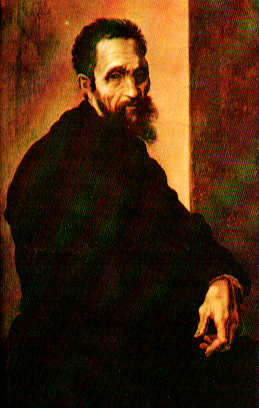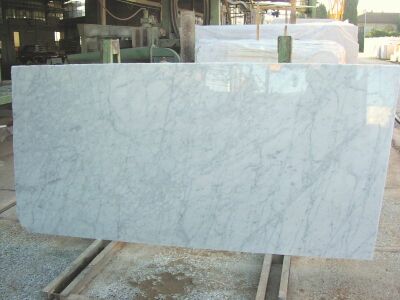
His Birth, Childhood and Youth
 Michelangelo was born on March 6, 1475. He was the 2nd among five children of the family. Michelangelo was just one month-old when his family moved back to Settignano, a village situated on the Florentine hills, just a few kilometers from the city. Buonarroti's mother, Francesca Neri, was too sick and frail to nurse Michelangelo, so he was placed with a wet nurse, in a family of stone cutters, where he, "sucked in the craft of hammer and chisel with my foster mother's milk. When I told my father that I wish to be an artist, he flew into a rage, 'artists are laborers, no better than shoemakers."
Michelangelo was born on March 6, 1475. He was the 2nd among five children of the family. Michelangelo was just one month-old when his family moved back to Settignano, a village situated on the Florentine hills, just a few kilometers from the city. Buonarroti's mother, Francesca Neri, was too sick and frail to nurse Michelangelo, so he was placed with a wet nurse, in a family of stone cutters, where he, "sucked in the craft of hammer and chisel with my foster mother's milk. When I told my father that I wish to be an artist, he flew into a rage, 'artists are laborers, no better than shoemakers."
Buonarroti's mother died young, when the child was only six years old. But even before then, Michelangelo's childhood had been grim and lacking in affection. His father, Ludovico Buonarroti, was a minor Florentine official and the local governor (podestà,) of the small towns of Caprese and nearby Chiusi. After his six-month term of office, Ludovico moved the family back to Florence, where they owned a good-size farm in the little village of Settignano overlooking Florence. Here, and in the surrounding hills pock-marked with quarries, Michelangelo grew up and was first exposed to stone carving.
 The artist's father Ludovico, podesta of Chiusi and Caprese, descendant of the ancient Florentine family, sent him to study under the guiding of the humanist Francesco da Urbino. He showed the extraordinary artistic talent very quickly; encouraged by the friend Francesco Granacci, Michelangelo won the hospitality of a family and was accepted in the studio of Ghirlandaio (April 1488), with the contract of apprenticeship for 3 years. Beginning with the next year, he preferred to visit Medici's gardens of San Marco, where under the monitoring of Bertoldo di Giovanni, he studied ancient sculptures collected here. The painting on the right is entitled "Carrara" by Nikolai Ge, and it hangs at the Taganrog Museum of Art.
The artist's father Ludovico, podesta of Chiusi and Caprese, descendant of the ancient Florentine family, sent him to study under the guiding of the humanist Francesco da Urbino. He showed the extraordinary artistic talent very quickly; encouraged by the friend Francesco Granacci, Michelangelo won the hospitality of a family and was accepted in the studio of Ghirlandaio (April 1488), with the contract of apprenticeship for 3 years. Beginning with the next year, he preferred to visit Medici's gardens of San Marco, where under the monitoring of Bertoldo di Giovanni, he studied ancient sculptures collected here. The painting on the right is entitled "Carrara" by Nikolai Ge, and it hangs at the Taganrog Museum of Art.
In 1488, at the age of 13, Michelangelo entered the workshop of Domenico Ghirlandaio, which speaks highly of his budding talent, as Ghirlandaio was by this time an established and well-known painter, and could afford to be selective with his apprentices. Thus, Michelangelo came under the influence of Masaccio, because Ghirlandaio not only looked to Masaccio for ideas on depicting religious scenes. After leaving Ghirlandaio he studied at the sculpture school in the Medici Gardens where he enjoyed the patronage of Lorenzo de Medici, head of one of Europe's most powerful families.
Michelangelo first visited Rome in his twenties, and after repeated periods of residence in the papal city he settled there permanently in 1534. In the mid-1490s He moved to Rome where he quickly established his reputation as a talented artist.
 At the foot of the Apuan Alps in Italy sits the small town of Carrara where artists like Michelangelo hand picked the best marble for their statues. Carrara is the center of the world of marble: marble from elsewhere is sent to be cut in the hundreds of mills and studios. But in the two thousand years since Caesar Augustus used the first Carrara quarries to build imperial Rome, the hunt for the kilometers-thick veins of the more precious white marble has been primary. Michelangelo selected stone here. Carrara has been home to marble miners for two thousand years, which dates back all the way back to the time of Augustus. This limestone that turned into marble is some of the most famous marble in the world. It is expensive but worth every penny because of its resistance to weather.
At the foot of the Apuan Alps in Italy sits the small town of Carrara where artists like Michelangelo hand picked the best marble for their statues. Carrara is the center of the world of marble: marble from elsewhere is sent to be cut in the hundreds of mills and studios. But in the two thousand years since Caesar Augustus used the first Carrara quarries to build imperial Rome, the hunt for the kilometers-thick veins of the more precious white marble has been primary. Michelangelo selected stone here. Carrara has been home to marble miners for two thousand years, which dates back all the way back to the time of Augustus. This limestone that turned into marble is some of the most famous marble in the world. It is expensive but worth every penny because of its resistance to weather.
THE TOWN OF CARRARA & MICHELANGELO'S MARBLE
The derivation for the word "Carrara" likely comes from the ancient term "Kar" (stone). Ancient Romans quarried the marble, loaded it onto ships at the port of Luni and took it to Rome by sea. According to Saint Girolamo, the name Carrara derives from “CAR” which means "wagons." Another hypothesis (Repetti) is that the term is derived from the French “CAREERS”, which in turn is borrowed from “CARRARIAE”, a Latin term meaning quarry. Carrara may derive from a preroman term : “KAIR” (celtic) or to one from Liguria: “KAR”, that means "stone" and therefore: “CAR+ARIA” meaning “PLACE OF STONES”; or a place in which many stones are found.
LUNA OR CARRARA MARBLE. This marble, a brilliant, fine-grained white sedimentary stone, comes from the quarries near the modern town of Carrara (the ancient Luna) in the northwestern part of the Italian peninsula. It is a very hard stone which will take a fine polish and which resists discoloring. The Romans first discovered and opened the quarry in the middle of the first century BC, and we begin to find it used for large-scale building projects in the time of the emperor Augustus. Because of its fine grain and potentially smooth surface, it was popular with sculptors both Roman and later, and Michelangelo used Carrara marble regularly, for such statues as the Pietà and the Moses. Michelangelo's "Moses" is the statue on the right.
MICELANGELO'S WORK AS A SCULPTOR
Michaelangelo worked as a painter, sculptor, architect, and poet until the age of almost ninety. In his last years, the artist returned to his scupture, executing the Pieta, (c. 1550; Cathedral, Florence) that he intended to have placed on his own tomb. The aged and resigned features of the figure of Nicodemus supporting the Christ constitute a self-portrait--the picture of an old and tired believer who willingly accepts the inevitability of his own mortality and the possibility of his soul's salvation as he contemplates the features of the Christ. In this, his most intimate statue, Michelangelo manifests his deeply moral philosophy, his poetic expression, and the universality of his imagery; he identifies the divine source of that spark of creativity that sculpted him into one of the greatest of all artistic geniuses.
Michelangelo was 75 years old, in 1538-39, when plans were under way for the remodeling of the buildings surrounding the Campidoglio (Capitol) on the Capitoline Hill, the civic and political heart of the city of Rome. Although Michelangelo's program was not carried out until the late 1550s and not finished until the 17th century, he designed the Campidoglio around an oval shape, with the famous antique bronze equestrian statue of the Roman emperor Marcus Aurelius in the center. For the Palazzo dei Conservatori he brought a new unity to the public building façade, at the same time that he preserved traditional Roman monumentality. However, since 1546 he had been increasingly active as an architect; in particular, he was Chief Architect to St Peter's and was doing more there than had been done for thirty years. This was the greatest architectural undertaking in Christendom, and Michelangelo did it, as he did all his late works, solely for the glory of God.
A LEGACY OF GENIUS
As Michelangelo became increasingly frail, he worked less on sculpture and more on architectural designs and religious drawings. His artistic output in the last years of his life consists of a number of these drawings, many of the Crucifixion, and two final pietas. Michelangelo worked on these intensely personal pieces tenaciously, although he left most of them unfinished. Their rough and unfinished states may be partly intentional, and they are certainly more emotionally expressive because of their roughness.
Years of painting, especially while working on the ceiling frescoes while lying on his back (very uncomfortable and awkward physical conditions), was hard on Michelangelo's body. He was often in pain. Michelangelo died in Rome in 1564. The artist worked to within a few days of when he died, on February 18, 1564 after a "long fever, and just two weeks shy of his eighty-ninth birthday. The year Galileo and William Shakespeare were born.

